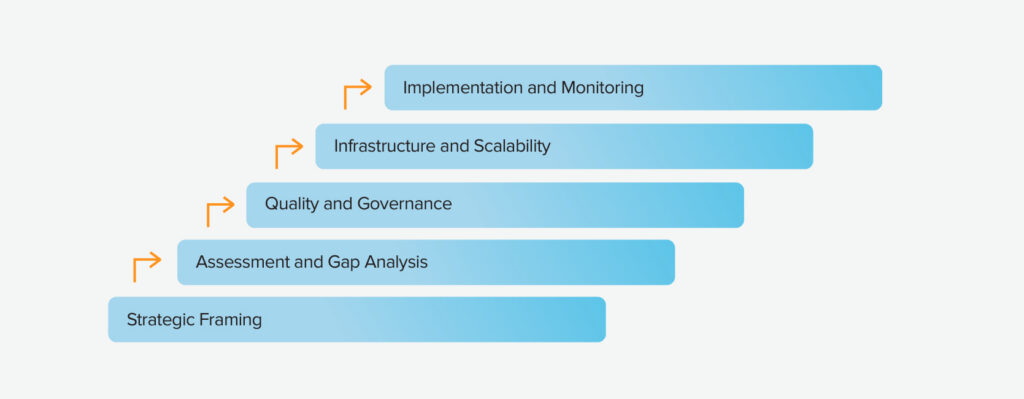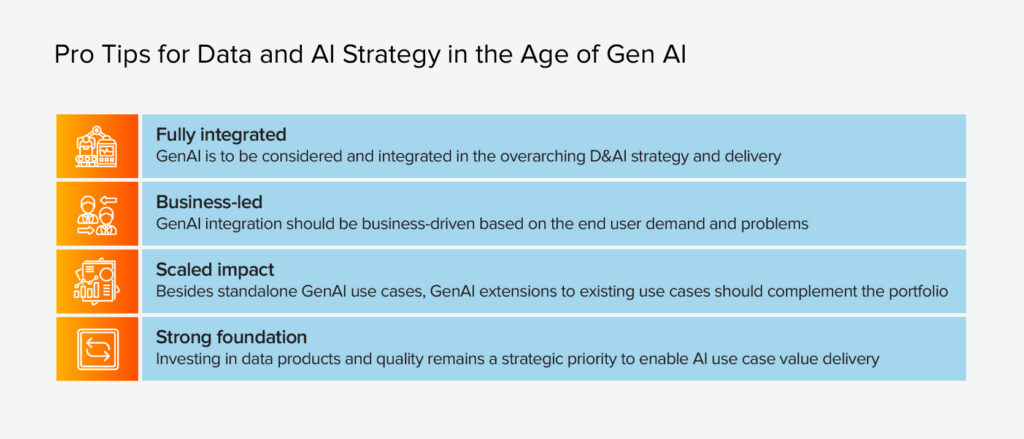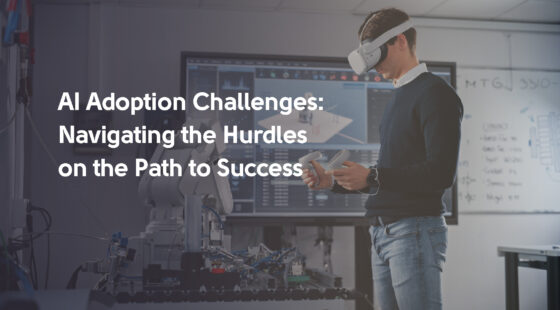Did you know that many AI projects fail not because of the technology but because of poor data planning? Without a solid AI data strategy, even the smartest models can produce unreliable results or miss key business goals. A well-designed strategy makes sure your data is accurate, accessible, and aligned with your AI goals. It also helps you manage growth, maintain quality, and reduce bias, so your AI projects scale smoothly. In this guide, we’ll walk you through each step to build an AI data strategy that creates real impact.
Data and AI Strategy: The Essential Alignment
Let’s start with the basics and clarify the key difference between the concepts of a data strategy and an AI strategy.
A data strategy is like a detailed plan for how a company gathers, stores, manages, shares, and uses its information to make smarter decisions and run more smoothly.
On the other hand, an AI strategy is all about guiding how to use artificial intelligence tools, such as machine learning and predictive analytics, to hit specific business targets, foster innovation, and stay ahead of the competition.
Aligning these strategies is crucial because AI relies heavily on high-quality, well-managed data to function effectively. If the data isn’t good or properly governed, AI projects can get stuck in silos, face scaling issues, and produce unreliable results, which leads to wasting resources and missing chances to improve. Proper data integration becomes a solid foundation for AI, helping the project stay flexible, act ethically, and drive long-term business change.
| Traditional Data Strategy | AI-Focused Data Strategy | |
| Focus | Data storage, governance, and basic reporting for operational efficiency | Data as fuel for AI models, emphasizing real-time processing, pattern recognition, and predictive insights |
| Key Metrics | Data accuracy, completeness, and compliance rates | Model accuracy, prediction reliability, ROI from AI initiatives, and innovation impact |
| Tools | Databases, Extracting, Transforming, and Loading data (ETL) tools, Business Intelligence (BI) dashboards | Machine learning platforms, data lakes, NLP tools, and cloud-based AI services |
For example, in healthcare, AI tools like machine learning help analyze medical images to catch diseases early. For these systems to work well, they need high-quality, diverse patient data to learn from. This helps ensure the results are reliable, which can improve patient care and reduce mistakes. It helps people make smarter, more informed decisions, especially in areas where AI plays a role.
AI Data Strategy: Step-by-Step Roadmap
Creating an AI data strategy involves taking a gradual approach that blends effective data management with clear AI objectives. The guide below is built on tried-and-true frameworks, emphasizing the importance of aligning your data assets with your AI capabilities to avoid common pitfalls like disconnected efforts or limited growth. These steps are designed to be practical and adaptable to different organizational needs, typically taking anywhere from 3 to 12 months, depending on the organization's maturity.

Step 1: Strategic Framing
To get started, define clear AI goals that align with your overall business objectives. This provides a strong foundation for your AI initiatives. During this initial phase, you should:
- Ensure executive buy-in
- Identify high-impact use cases, such as using predictive analytics to improve customer retention
- Develop a high-level AI data strategy that shows how data will propel your AI transformation.
Key activities include holding stakeholder workshops to prioritize projects based on potential return on investment and feasibility, as well as drafting an initial business case with measurable outcomes like cost reductions or increased revenue.
Example: A company might focus on using AI to detect fraud by analyzing historical transaction data, making sure their strategy stays relevant with industry trends and offers a competitive edge.
| Pro tip Secure leadership buy-in early and use tools like SWOT analysis to refine the vision, aiming for completion in 1-2 months. |
Step 2: Assessment and Gap Analysis
Take a thorough look at your current data landscape to understand how prepared you are and to spot any gaps. List all your datasets, whether structured or unstructured, and assess the quality and accessibility of your data sources. Look for silos or areas where information might be missing, such as real-time supply chain metrics crucial for AI. This process should also include an evaluation of your infrastructure, governance, and talent against industry benchmarks to uncover weaknesses like outdated systems or skill shortages.
Example: An e-commerce business might discover that customer data is scattered across different departments, making it harder to personalize experiences using AI.
| Pro tip Consider the following actionable sub-steps: - Identify data assets with tools like data catalogs - Conduct gap analysis through surveys or audits - Prioritize fixes based on AI use case impact, focusing on 1-3 months. |
Step 3: Quality and Governance
Focus on ensuring the quality of your data rather than just accumulating large amounts. Develop clear processes for cleaning, standardizing, and reducing bias to produce trustworthy AI results. Set up a solid governance structure with clear ownership, access controls, and compliance routines for regulations like GDPR or CCPA, while also tracking data history for transparency. In this phase, address risks, such as biased models in generative AI, by using methods like automated validation and adherence to ethical standards.
Example: In healthcare, having data from many different patients helps prevent diagnostic AI from unfairly favoring some groups over others.
| Pro tip Implement continuous monitoring tools and establish cross-functional governance teams, dedicating 2-4 months to develop strong policies. |
Step 4: Infrastructure and Scalability
Build a flexible system that can handle growing AI needs. This includes using storage options like data lakes or cloud services to organize all types of data, both structured and unstructured. Set up processes that can analyze data in real time and automatically move data through different stages to be ready for AI use and easy to expand in the future. Think about adding new technologies like sensors or blockchain to improve how data moves and is managed.
Example: A manufacturing company might deploy cloud-based systems for predictive maintenance AI, which allows seamless scaling across global operations.
| Pro tip Consider taking the following actions: - Choose vendors for AI platforms - Set up sandbox environments for testing - Plan for 2-6 months, incorporating cost estimates and hybrid models. |
Step 5: Implementation and Monitoring
Start by testing the AI solutions for key tasks and keep an eye on how well they perform, using simple measures like accuracy or return on investment. As you go, make improvements based on the feedback you receive. This stage also involves putting the AI into use, training your team to work with it, and checking regularly to catch issues like data changing unexpectedly. Use flexible, step-by-step methods to keep improving, while making sure everything is done ethically and that the project delivers real value.
Example: In retail, using AI for inventory optimization may include real-time dashboards to track decreases in stockouts.
| Pro tip Define success metrics upfront, schedule regular reviews, and aim for full rollout in 3-6 months, with perpetual monitoring to adapt to evolving needs. |
How AI and Big Data Can Boost Your Business Strategy
The way AI and Big Data work together is changing how businesses plan and succeed. They help companies make smarter decisions based on data, giving them an edge over competitors. Together, they turn huge amounts of data into insights that can lead to new opportunities for growth and innovation.
Key Benefits
AI and Big Data turn huge amounts of data into insights that can lead to:
- Operational efficiency: AI helps make complicated tasks easier, like managing supply chains. This means saving money and time. For instance, Amazon uses AI in its logistics to make things run smoothly and deliver packages faster.
- Customer engagement: Personalized marketing efforts that use AI can boost conversion rates by up to 30%. This is possible because they analyze customer behavior in real time, helping you connect more effectively.
- Innovation: AI helps identify emerging market trends and new product opportunities by analyzing viewer preferences through data-driven content creation strategies.
Example: Netflix’s recommendation engine, powered by artificial intelligence, has become a huge success. It studies what you watch and uses that information to suggest shows and movies you’re likely to enjoy. In fact, it influences about 75% of what viewers decide to watch, helping to keep people engaged and coming back for more with personalized content just for them.
Without a clear strategy, businesses often struggle with data overload, where overwhelming amounts of unprocessed information lead to inefficiencies and missed opportunities. This can result in significant resource wastage, potentially costing companies millions.
If you're looking to understand your customers better and make your operations more efficient, Svitla Systems offers customized AI solutions that help you analyze big data more effectively, so your business can grow and run smoothly.
Data Strategy for Generative AI
Generative AI, or Gen AI, can craft text, images, videos, and even code. It relies on carefully chosen data to drive innovation, but it also requires us to consider potential risks. Understanding its needs and core components, organizations can create applications that are both effective and ethical.

Source: PwC
Specific Needs
Generative AI requires diverse data to learn effectively for tasks like creating images or training large language models (LLMs). This data must cover various topics to prevent errors, such as inventing facts due to data gaps. According to McKinsey, as Gen AI expands, companies will need to focus on collecting high-quality data to meet the rising computational demands by 2030.
Key Elements
| Element | Description |
| Sourcing | Effective data sourcing for Gen AI involves combining internal, external, and synthetic data to ensure comprehensive training while respecting privacy. - Internal data, like customer records, aids tasks such as automating RFPs (Requests for Proposal) in B2B. - External data from public sources enhances general knowledge, improving model accuracy. - Synthetic data generated by tools like GANs addresses data shortages, especially for training image datasets, without the cost or risks of collecting real data. This diverse mix scales datasets and enhances model robustness. |
| Unstructured data | Handling unstructured data like images, text, and videos, which comprise about 80-90% of enterprise data, poses real challenges in GenAI projects. Effective use requires processing and organization through techniques that extract meaningful info from sources like: - Emails - Social media - IoT sensors. Machine learning algorithms format this data, making it easier to integrate with structured datasets. For instance, adding sentiment analysis from audio or video calls to customer data generates richer insights. Building semantic layers to interpret complex, domain-specific info makes data actionable and improves GenAI's accuracy and context awareness. |
| Ethics | Building ethical AI data strategies is the foundation for trust, privacy, and fairness. Compliance with regulations like GDPR protects sensitive information, while diverse datasets and regular audits help minimize bias in areas like healthcare and hiring. Strong governance adds transparency and accountability, giving stakeholders confidence in AI-driven decisions. When organizations get this right, they can innovate responsibly, creating AI that’s not only powerful but also fair and safe. |
Which Strategy Has the Greatest Impact on the Data Quality in Generative AI Models?
When it comes to building an AI data strategy, you’ll hear a lot about different approaches: improving data quality, sourcing diverse datasets, or setting up continuous monitoring. While all of these matter, governance tends to have the biggest impact. Good data governance doesn’t just set rules, it keeps data consistent, tracks where it comes from, and makes sure it meets compliance standards. This creates a solid foundation for AI projects and builds trust in the results.
Without governance, the risks pile up quickly. Models can produce biased or inaccurate outcomes, teams may lose confidence in the system, and businesses could face costly compliance issues. That’s why it pays to make governance a priority from the very beginning of any generative AI project. Starting strong means fewer mistakes, more reliable AI, and faster results you can actually trust.
Common Challenges and Best Practices
A strong AI data strategy is the foundation of every successful AI project. Yet many organizations struggle with obstacles that hold back real impact. The solution? Cross-functional collaboration, continuous validation, and agile iteration that together transform challenges into opportunities for success.
Challenges
The key hurdles that make it difficult to put an effective AI data strategy for a project into place include:
- Data silos
When departments or systems don't share information, it results in incomplete data and makes collaboration harder. This can also slow down the development of effective AI models.
- Data Bias
Inconsistent, incomplete, or biased data can lead to unfair results in AI systems, which can damage trust and reduce their accuracy.
- Scalability
Bigger AI systems come with bigger data demands. When infrastructure falls short or data quality is uneven, performance quickly takes a hit.
Best Practices
Every challenge has a solution. To avoid reinventing the wheel, use the best practices that are already established.
Cross-Functional Teams
Organizations benefit most when they bring data scientists, IT, business leaders, and domain experts together in cross-functional teams. This kind of collaboration breaks down silos, makes data sharing easier, and keeps AI goals aligned with business priorities.
Continuous Audits
Keeping AI trustworthy requires ongoing checks. Continuous audits of data quality, performance, and compliance uncover issues in real time, and automated monitoring helps ensure fairness to keep everything aligned with regulations.
Agile Iteration
Adopting an agile, step-by-step approach makes AI data strategy more flexible. Teams can quickly adjust to feedback and changing needs, using rapid prototyping and testing to refine processes and keep the strategy aligned with project goals.
Data Governance Framework
Strong data governance is about creating clarity and trust at every stage of the AI journey. A well-structured framework sets clear rules for who can access data, how its quality is maintained, and how it is kept secure. This consistency reduces errors, minimizes risks, ensures teams are working with reliable information, and builds confidence that AI decisions are based on accurate, secure, and responsibly managed data.
Data Integration Tools
Using modern, cloud-based data integration tools can transform how organizations manage their data. These solutions unify everything into a streamlined platform, making data aggregation and preprocessing easier and resulting in cleaner, more reliable information. As your business grows, these tools help scale effortlessly.
To sum up the key challenges and the solutions that correspond to each of them, have a look at the brief chart below:
| Challenge | Mitigation Strategy |
| Data silos | Form cross-functional teams to break down barriers and ensure integrated data access. |
| Data bias | Implement continuous audits to monitor and correct biases in datasets and models. |
| Scalability | Consider agile iteration for scalable, adaptive data management and infrastructure scaling. |
Summing Up
Ultimately, a solid AI data strategy turns ideas into tangible results. When data and AI strategies work together and challenges like silos, bias, and scalability are addressed with best practices, AI projects have the foundation they need to succeed. It’s not just about having a lot of data — it’s about having the right data, used properly. With a clear strategy, organizations can move faster, make smarter decisions, and unlock real business value from AI.
And if you require professional assistance on the matter, reach out to our team of AI experts.





